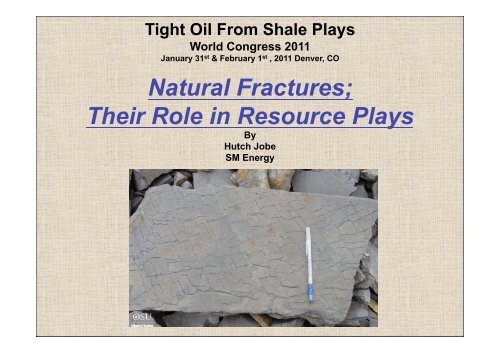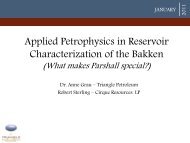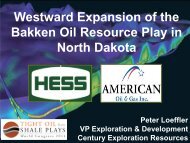Hutch Jobe, SM Energy - Tight Oil From Shale Plays World ...
Hutch Jobe, SM Energy - Tight Oil From Shale Plays World ...
Hutch Jobe, SM Energy - Tight Oil From Shale Plays World ...
You also want an ePaper? Increase the reach of your titles
YUMPU automatically turns print PDFs into web optimized ePapers that Google loves.
<strong>Tight</strong> <strong>Oil</strong> <strong>From</strong> <strong>Shale</strong> <strong>Plays</strong><br />
<strong>World</strong> Congress 2011<br />
January 31 st & February 1 st , 2011 Denver, CO<br />
Natural Fractures;<br />
Their Role in Resource <strong>Plays</strong><br />
By<br />
<strong>Hutch</strong> <strong>Jobe</strong><br />
<strong>SM</strong> <strong>Energy</strong>
1970’s<br />
<strong>Tight</strong> Gas Sands (TGS)<br />
Confined to deep basin areas<br />
Recognize no distinct LKG<br />
Recognized perm as a driver<br />
Recognized pervasive Sw<br />
Unconventional pay concept born<br />
1980’s<br />
TGS plays expanded/evolved<br />
Recognition of over pressuring<br />
Basin Center Gas concept<br />
<strong>Tight</strong> Gas tax credits<br />
Improvements in 2D and 3D<br />
Role of natural fractures emerges<br />
Evolution of the Resource Play<br />
1990’s<br />
CBM become vogue<br />
Realization of sorbed & absorbed gas<br />
Recognition of coal composition<br />
Fractures and cavitation in coals<br />
Dewatering concept<br />
Pattern & high density drilling<br />
Antrim & Barnett <strong>Shale</strong> play emerge<br />
Image logging is greatly enhanced<br />
2000’s<br />
<strong>Shale</strong> Resource <strong>Plays</strong> explode<br />
Source rocks become reservoirs<br />
Horizontal drilling becomes an art form<br />
Horizontal logging and frac’ing evolve<br />
Multi-stage completions<br />
3D is a “must”<br />
Micro-Seismic becomes very popular<br />
Natural fractures are key to perm<br />
2010’s<br />
Resource play targets not lithodependent<br />
Brittleness, TOC, natural fractures are key<br />
Designer frac’s optimize induced fractures<br />
Source and carrier bed relationships<br />
Sequence stratigraphic framework<br />
Aggregate development drilling<br />
Surface array/Buried array micro-seismic<br />
Simal-fracs and Zipper-fracs<br />
Go horizontal in produced TGS fields<br />
Vertical drilling phases out to horizontal<br />
<strong>Shale</strong> oil and oil resource play focus
Misconceptions about Resource <strong>Plays</strong><br />
They are all shales; you stimulate them all the same;<br />
stimulation of the matrix makes the play; and they should all<br />
produce the same.<br />
The prospective Resource Play is an unconventional<br />
reservoir.<br />
Since nothing shows up on seismic, the reservoir is not<br />
fractured; we drill in “quiet areas” where no faulting is<br />
present.
What is the definition of a <strong>Shale</strong>?<br />
Grain Size and Bedding are the controlling factors defining a <strong>Shale</strong><br />
Bedding Thickness<br />
.0625 mm .0039 mm < .0039 mm<br />
(1/16 inch)<br />
(1/256 inch)<br />
Grain Size<br />
(Modified Rose & Assoc.; from Levine, 2003)
Thinly Laminated <strong>Shale</strong>s Interbedded with<br />
Siliceous Layers; Woodford <strong>Shale</strong>
Lithologies of High Profile Resource <strong>Plays</strong><br />
Closest to a <strong>Shale</strong><br />
Barnett<br />
Woodford<br />
Fayetteville<br />
Marcellus<br />
SWS??<br />
Muskwa<br />
Conasauga<br />
Huron<br />
New Albany<br />
Antrim<br />
Bossier??<br />
Closest to a Limestone<br />
Eagle Ford<br />
Niobrara<br />
Closest to a Siltstone<br />
Haynesville (“stack”)<br />
Montney<br />
Mancos<br />
Bossier??<br />
SWS??<br />
Closest to a Clastic/Congl<br />
Granite Wash<br />
Closest to a Dolomite<br />
Bakken<br />
Three Forks<br />
Collingwood<br />
(Utica)
A Statement from Experience<br />
All reservoirs have some component of<br />
natural fracturing which contributes to the<br />
permeability within the rock
What is a Natural Fracture?<br />
---”discontinuity caused by brittle failure” (Narr etal, 2006); a compromise of the<br />
structural fabric in rock caused by stress (tectonic, HC, and impact generated)<br />
---a fracture can be a crack, joint, fault, deformation band or vein, and<br />
predominantly perpendicular to bedding<br />
---a fracture is a function of scale; some may have displacement, some may have<br />
have shear, but all impact the ability for fluid flow; transmissibility; permeability
The Role of Fracturing on Permeability Upon<br />
Compaction in Sandstones<br />
Fracturing therefore is beneficial for flow in <strong>Tight</strong> Gas Sands; natural and induced
How Do We Describe Natural Fracturing?<br />
Via Fracture Intensity>>>length, height, density, spacing, aperture,<br />
patterns, bed thickness, rock composition;<br />
relationships with curvature, structure, dip<br />
and faulting; it’s 3-dimensional<br />
(Hennings, 2006)<br />
Understand the difference between closed/healed fractures<br />
versus cemented fractures<br />
Closed fractures on a surface do not imply they are closed<br />
throughout the volume, cemented fractures can
Key Drivers to Resource Play Performance<br />
Know the Structural History; Understand Natural Fractures<br />
Know the Rock; Sequence Stratigraphic Framework<br />
Brittleness: Understand Rock Properties<br />
TOC Content; % Percent by Weight, Kerogen Type<br />
(richness), and Maturity ( Ro--heat)<br />
3D Seismic and Micro-seismic; Fault Geometries, Fault<br />
Magnitudes, SRV<br />
Stimulation Procedures
Structural Setting Determines Natural<br />
Fracture Geometry<br />
Drape over<br />
structural highs<br />
Dip-slip & Strike-slip<br />
faulting generate fracturing<br />
*Natural fractures can help<br />
determine productive limits<br />
associated with Resource <strong>Plays</strong>*<br />
Enhancement via<br />
structural closure<br />
(Modified Rose & Assoc.; Steward, 2009)
Silo Field Isocum Map: Fractured Niobrara<br />
0 to 50 MBO<br />
50 to 100 MBO<br />
100 to 150 MBO<br />
150 to 200 MBO<br />
>200 MBO<br />
12 wells have produced between<br />
200 MBO to 481 MBO<br />
*Data comes from 114 producers; Swanson mean of 74 MBO; range is .3 to 481 MBO*
Silo Field Isocum Map: Fractured Niobrara<br />
0 to 50 MBO<br />
50 to 100 MBO<br />
100 to 150 MBO<br />
150 to 200 MBO<br />
>200 MBO<br />
12 wells have produced between<br />
200 MBO to 481 MBO<br />
*Data comes from 114 producers; Swanson mean of 74 MBO; range is .3 to 481 MBO*
Sequence Stratigraphic Framework Helps<br />
Define the Resource Target<br />
(modified)<br />
Off lap sands and<br />
washes<br />
Key attributes: position of the margin, geometry of margin, angle of slope,<br />
fauna diversity optimizes TOC, water depth governs TOC, water depth<br />
governs facies
Rock Properties<br />
---Brittleness; the ability for rock to fracture<br />
naturally or fracture via stimulation; it can be<br />
proportional to permeability and stimulation<br />
enhancement<br />
---Brittleness and elasticity is a function of<br />
lithology/composition<br />
---Siliceous and dolomitic rocks tend to be<br />
more brittle than limestones and clay rich<br />
rocks; clay in rock correlates to more<br />
ductility
Thermal Maturation Windows for<br />
Various Resource <strong>Plays</strong><br />
Eagle Ford<br />
Marcellus<br />
TOC %<br />
(modified: Bustin etal, 2008)
Kerogen Types and Their Link to Ro,<br />
Tmax, HC Phase, and HC Efficiency<br />
Lacustrine,<br />
<strong>Oil</strong> Prone<br />
Marine,<br />
<strong>Oil</strong> Prone<br />
Terrestrial,<br />
Gas Prone<br />
(After Rose & Assoc,; Modified Jarvie, 2009)
In Source Rock Resource <strong>Plays</strong>; Understanding Relationships Between<br />
Fracturing Caused by Hydrocarbon Generation, Maturation, and Kerogen<br />
Type Can be Important<br />
(unpublished, MacKay, 2010)<br />
Thermal maturation of organic material can affect fluid type in terms of molecule<br />
size and compressibility (this can influence the areal extent of the pressure event)
Micro-Seismic has Evolved into an Important<br />
Part of Resource Play Development<br />
---Down-hole monitor approach: initial application; monitor well can be<br />
expensive or difficult to position; data is usually good from a vertical aspect;<br />
fair to good lateral data<br />
---Surface array approach: gaining popularity; no monitor well is needed;<br />
reasonable expense; vertical resolution not as good as down hole; lateral data<br />
is good; additional permitting and preparation<br />
---Buried array approach: gaining popularity; no monitor well is needed; fairly<br />
expensive but can be used multiple times; vertical resolution similar to the<br />
surface array; lateral data is good; usually covers the largest area; additional<br />
permitting and preparation<br />
(Bennett etal <strong>Oil</strong>field Review, 2006)
(Duncan & Laking, 2006)<br />
Depiction of Surface Array Design<br />
---Vertical well case<br />
---Each radius approx. equal to<br />
depth of target<br />
---Multiple geophones per radius<br />
---Horizontal well case<br />
---Survey has an ellipse shape due<br />
to lateral wellbore length<br />
---Multiple geophones per radius
Depiction of Buried Array Design<br />
---Spacing of stations is a func. of<br />
budget, development plan,<br />
signal to noise, etc.<br />
---Depth of stations can vary but<br />
100’ to 300’ foot is common<br />
---Multiple geophones are hung in<br />
each station<br />
(MicroSeismic, 2010)
Map View & Cross Profile of Micro-Seismic Data<br />
Gaps in events suggest<br />
poor stimulation coverage;<br />
and the possible need for<br />
more stages<br />
Varying vertical growth<br />
of events suggests fracs<br />
might not be confined to<br />
target interval<br />
(Modified; MicroSeismic Website, 2010)
Surface Array Micro-Seismic Application<br />
**Damage zones associated with faulting<br />
can be detrimental during stimulation**
Map View of Events Associated with “Relax-a-Frac” Periods
Cross-Sectional View of Total Events During Stage<br />
Zone of<br />
Interest
Final Distribution of Events Throughout Lateral
Learning's and Value of Micro Seismic<br />
---Helps confirm in-zone stimulation<br />
---Helps define lateral extents of stimulation<br />
---Can calculate a stimulated rock volume (SRV)<br />
---Identify fracture orientation<br />
---Identify faulting<br />
---Identify “thief” zones during stimulation<br />
---Confirm spacing of frac stages along the length of the lateral<br />
---Confirm conductivity intensity of frac fluids and design<br />
---Helps identify well spacing, unstim. SRV, and potential recompl.<br />
Potential Re-fracs<br />
or new drill areas<br />
(Pinnacle Technologies Website, 2010)
How Can Geo-Science Effect Stimulation Design?<br />
---Accurate lithology/composition determines most effective frac design:<br />
a.) high clay content>>>more gel design<br />
b.) low clay content>>>more slick-water design<br />
c.) more brittle rock might not need as high a rate<br />
d.) elasticity of rock might give insight on pump procedures<br />
---Natural fracture and fault knowledge effects:<br />
a.) well placement<br />
b.) stage periodicity along lateral (length and spacing)<br />
c.) propant size, volume, and timing<br />
d.) SRV aerial size and distribution<br />
---3D Seismic and Micro-Seismic gives confidence to:<br />
a.) did we stay in zone<br />
b.) are we too close to a fault<br />
c.) did we land in the correct spot<br />
d.) does the target extend this far or in this direction<br />
---Understanding the rocks direct us to which resource plays we should<br />
pursue and which one’s we should avoid
In the past, we were concerned with the trap<br />
at the end of a hydrocarbon migration event.<br />
Now we are concerned with the pathway of<br />
the entire migration process.







